Fixing Android File Transfer Could Not Access Device Storage: Best Practices for macOS
Nothing in the technology world is more annoying than knowing that something should work, but just won’t. This is the problem many Android users have when attempting to connect their device to a Mac. Even if you’re working with Android File Transfer, an app renowned for its simplicity and ease of use, you’re still liable to end up with an error message telling you that the app could not access your Android’s storage. There are many reasons why this might happen when you try to connect your Android to a Mac, but luckily, most of them have easy solutions. Here are the best ways to fix connection issues if your Mac can’t access device storage.
Common Reasons Why Android File Transfer Can’t Access Device Storage
Frustratingly, there are quite a few reasons why you might not be able to access your Android’s storage from a Mac. The most common of these are as follows:
- Broken USB cable or ports. If you are using an old or third-party USB cable to connect your Android to your Mac, you may see an error; the same goes for using a broken USB port on your computer. This can be the reason for the common Android File Transfer “no Android device found” error.
- Outdated software. Whether it’s your macOS or Android software that’s out of date, making sure you’re updating both devices regularly can help prevent connection errors.
- Incorrect settings. If you don’t select the “File transfer” option on your Android when connecting it, you may not even see the option to transfer files.
- App conflicts. Some apps, like Samsung Kies or Smart Switch, can interfere with other file transfer apps (like Android File Transfer).
Try Android File Transfer Alternatives
A plethora of potential pitfalls when connecting an Android device to your Mac via Android File Transfer might make you think about alternatives to meet your needs without needing to actively fix Android File Transfer first.
MacDroid
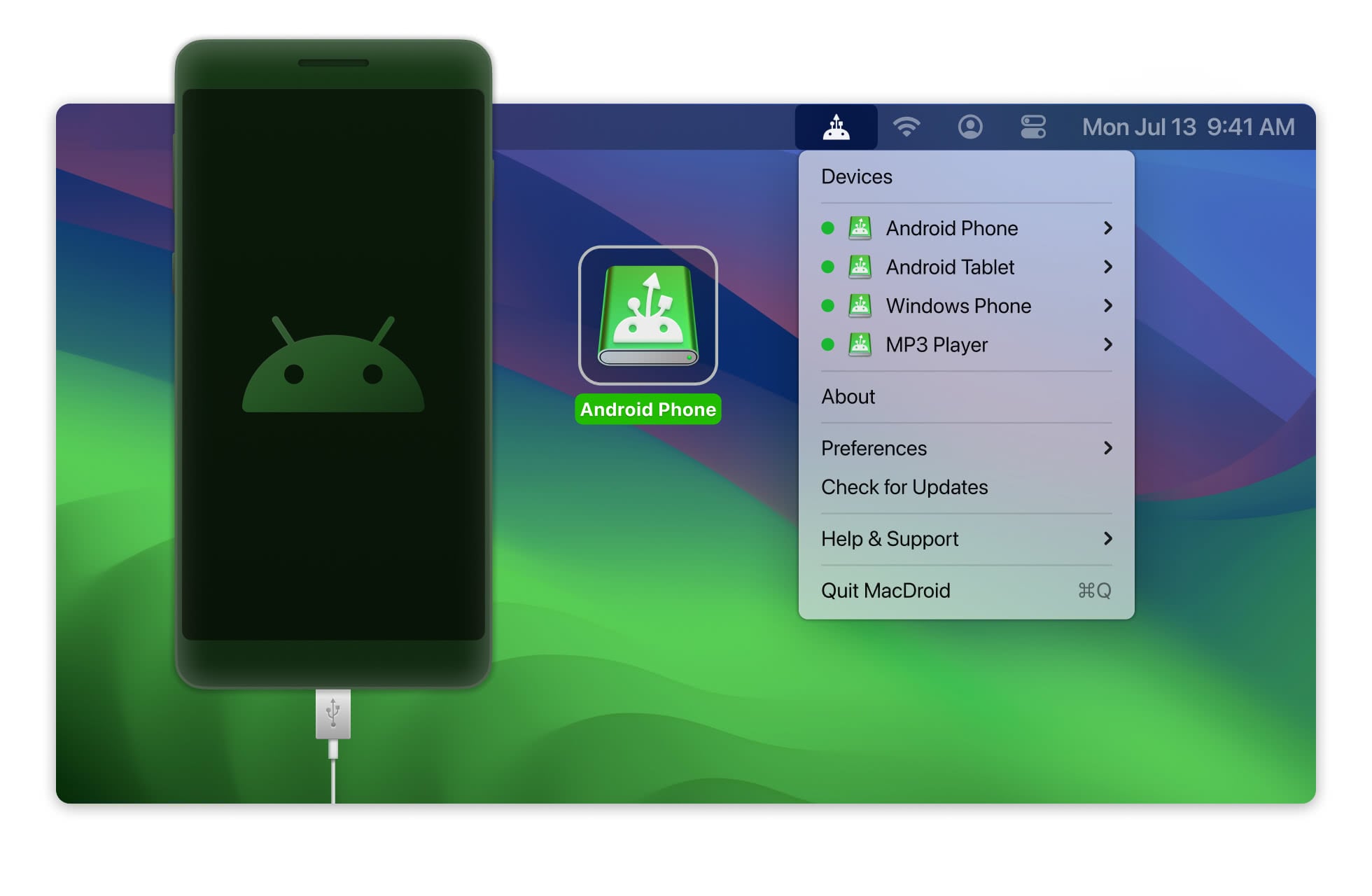
MacDroid is a simple and clean solution that lets you connect your phone to a Macbook. The interface is intuitive and basic enough to appeal to beginners, while the optional advanced ADB transfer mode and robust settings should be alluring to professional Android users. The file transfer process treats your Android like a separate drive, making it easy to click and drag files to move between your Android and your Mac. Since all of this takes place via a USB cable, you can expect MacDroid to transfer files to and from your Android with fast speed.
The free version allows you to transfer files from Android to Mac (one direction only). The Pro version (which costs $19.99 per year) opens the possibility to transfer files in both directions. The reliability and general ease of use that MacDroid provides, not to mention having guaranteed compatibility with current and future iterations of macOS – is more than worth the price tag for anyone who anticipates performing file transfers more than a couple of times per year.
How to Use MacDroid
- Download and install MacDroid on your Mac.
- Open MacDroid, then connect your Android via its USB cable.
- Select either MTP or ADB when prompted by MacDroid. We recommend MTP for first-time users.
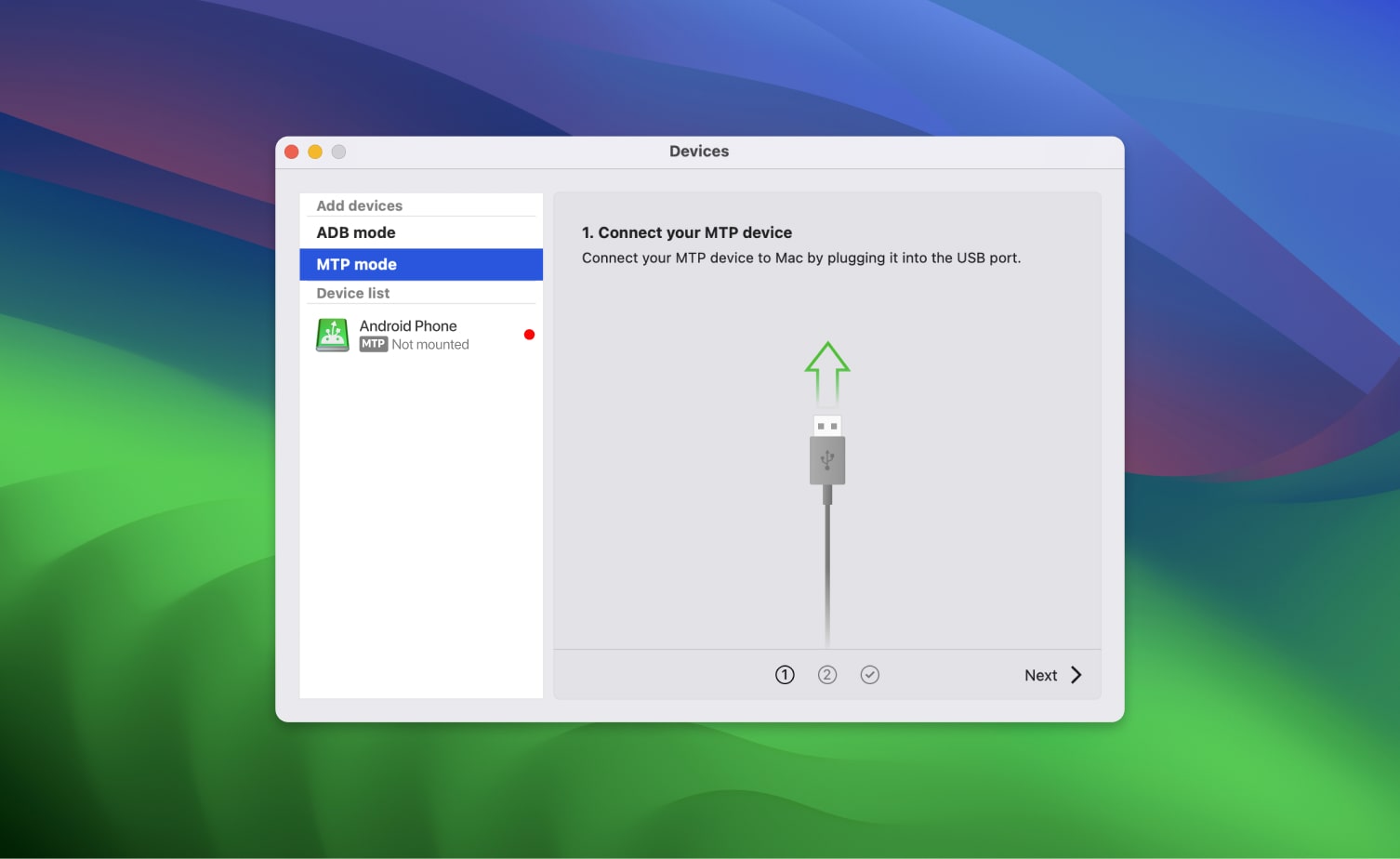
- Follow the on-screen prompts until you see that your Android device connection is complete.
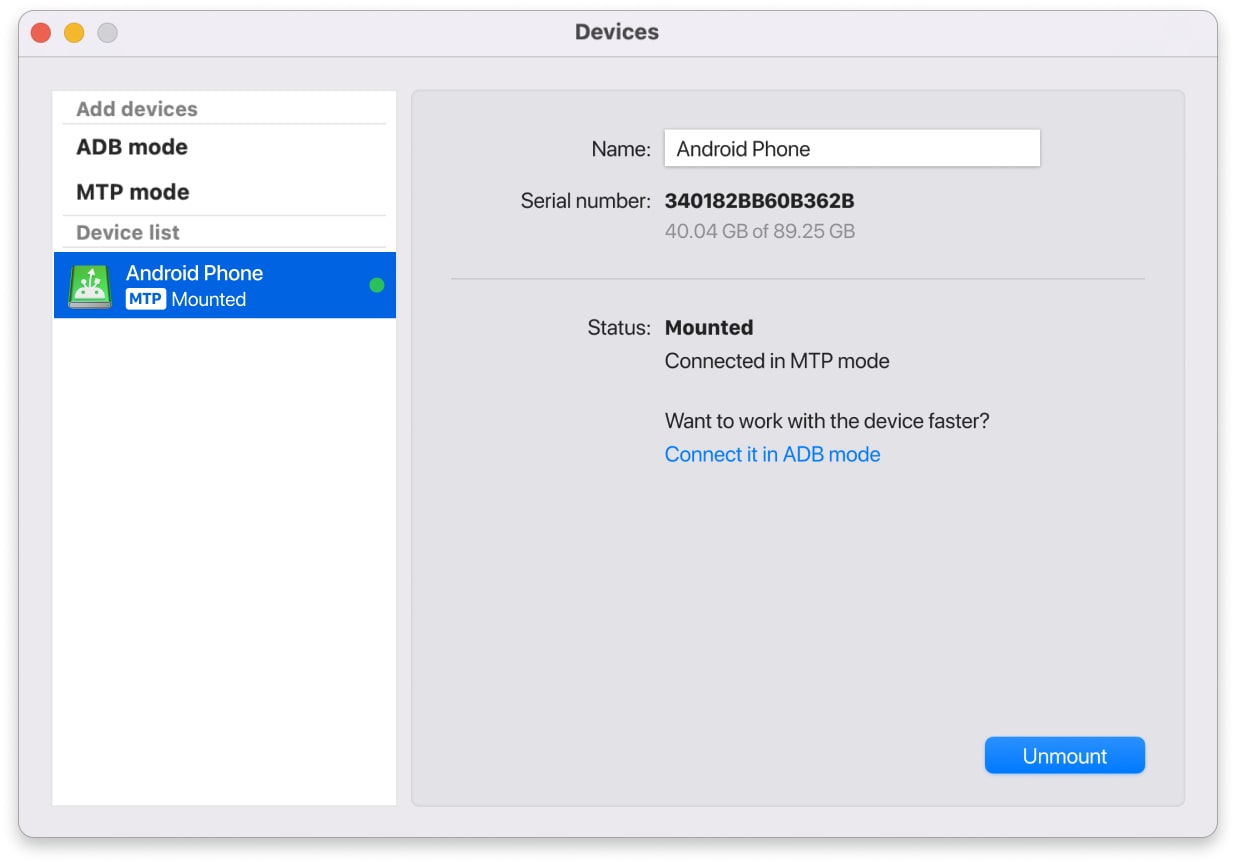
- Select files to transfer via the MacDroid app window.
OpenMTP
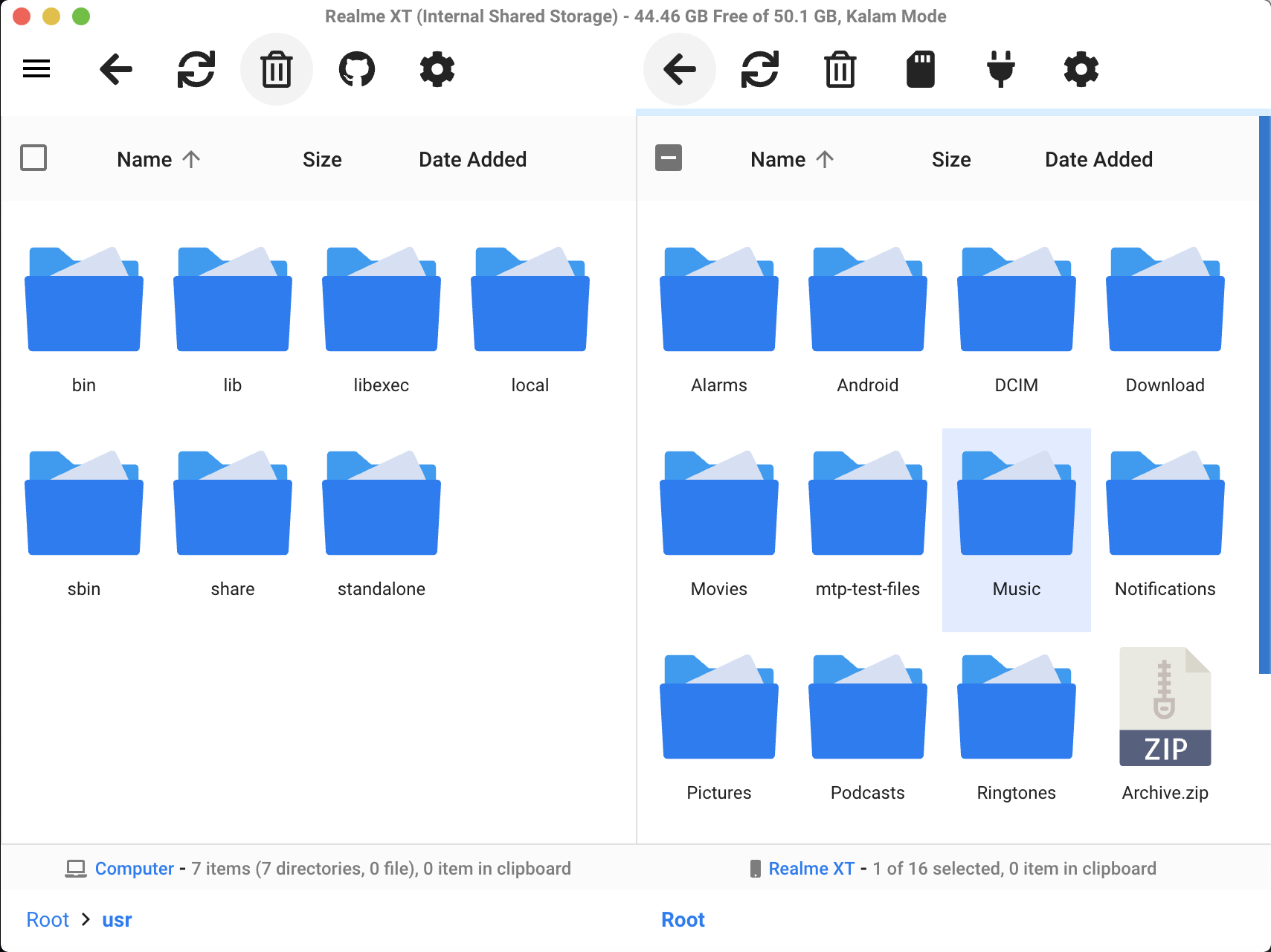
Sometimes, figuring out how to fix Android File Transfer on Mac is as simple as picking a different tool. OpenMTP is a worthy alternative to the free Android File Transfer for two main reasons: It is also free, and it is open-source, meaning you’ll benefit from free and constant updates that are community-driven and ostensibly transparent. These are features that make OpenMTP’s relatively basic interface and potentially lackluster feature list excusable. If all you need to do is move files from one device to another with as few frills as possible, OpenMTP has you covered.
Open MTP is also compatible with pretty much any macOS and Android devices you would feasibly own at this point, so you should be able to use it regardless of your device type or model.
How to Use OpenMTP
- Download OpenMTP and install it.
- Connect your Android device to your Mac via the included USB cable.
- When prompted on your Android, select the “File transfer” option in the “Charging” notification (you may first have to open the notification shade).
- Click Refresh in OpenMTP, then select files to transfer.
Dr.Fone
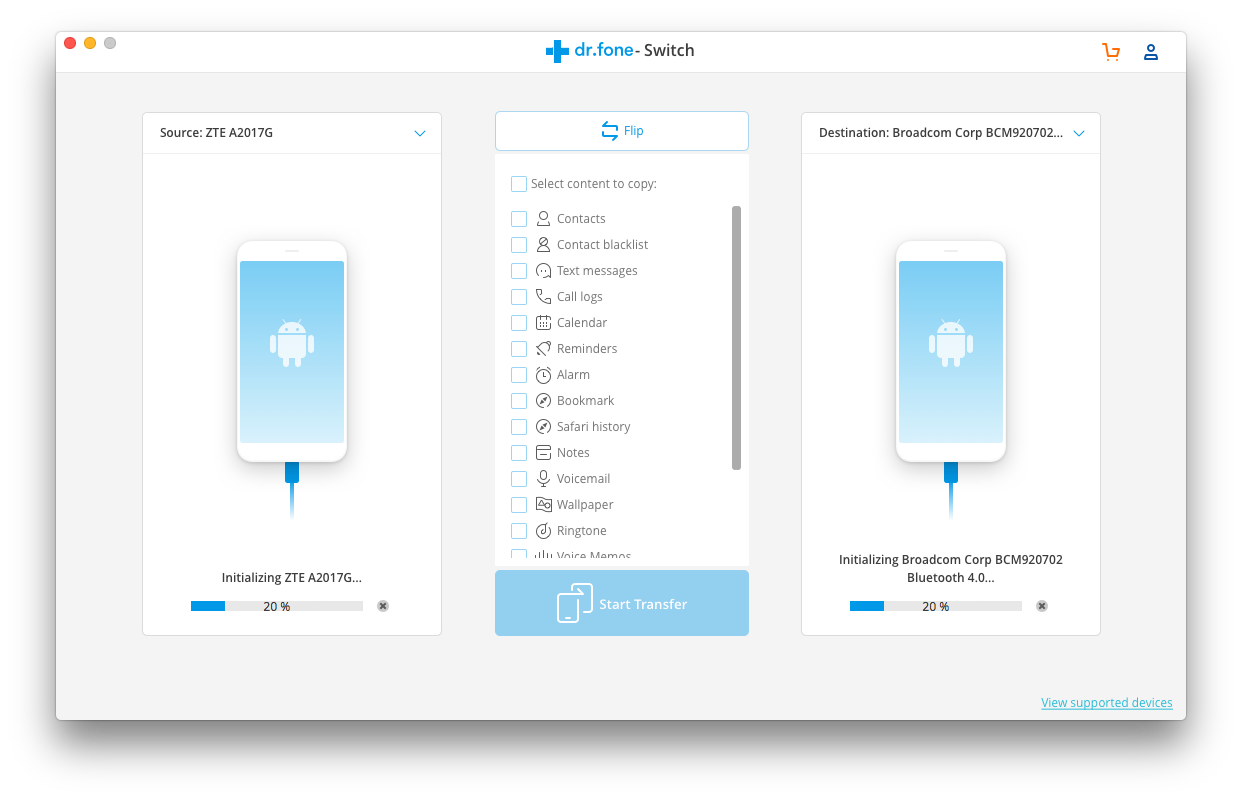
Dr.Fone’s Android file transfer app is one of those where you know exactly what you’re getting when you buy it. If you’re someone who struggles with overly simplistic or advanced apps and you need a fairly well-guided tour through the different options for transferring Android files, Dr.Fone’s app is a good bet as long as you don’t mind paying a premium. In addition to all of the basic file transfer options you’d expect, Dr.Fone also allows Android-to-iPhone transfers, quick movement for 15 different file types, and a combination of both USB and wireless connections.
The downside is that Dr.Fone lacks strong customization options that power users will undoubtedly miss, and the price tag, at $29.95 per year, is steep, especially in comparison to other premium apps like MacDroid. Nevertheless, Dr.Fone is a strong contender if you just want to click a few icons to move files back and forth.
How to Use Dr.Fone
- Download the app from the Dr.Fone website.
- Connect your Android with its USB cable, then click Phone Manager in the app window.
- When your Android appears, select your media file type (e.g., “Photos”) in the app.
- Select files to transfer, then click the Export button.
AnyDroid
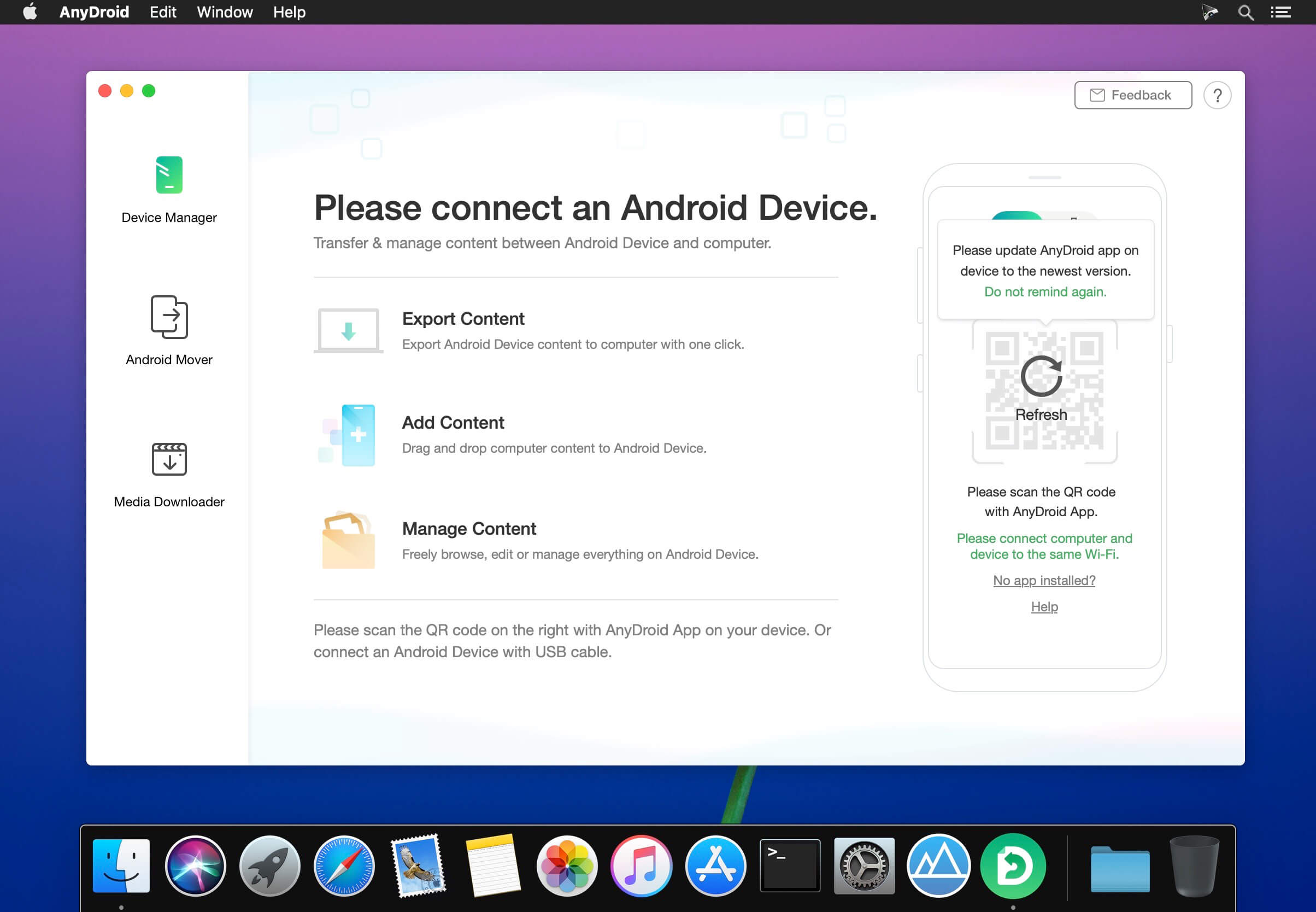
As mentioned, Android File Transfer not working on Mac is a regrettably common occurrence. AnyDroid is a simple and UI-forward alternative that can fill the AFT void for power users and novices alike. This app boasts a one-click backup feature that makes preserving your Android’s files a breeze, and it makes use of a wireless QR code feature that you can select to transfer files while on the go if you don’t have a cable.
AnyDroid is also expensive by any metric, requiring a $49.99 purchase for a lifetime license or $39.99 per year for ongoing access. This makes it a less attractive option than other options on this list since it doesn’t exactly surpass any of the cheaper options here in tangible ways. The wireless option is nice, but not unique to AnyDroid, and it will result in lower transfer speeds than simply using the cable that came with your device.
How to Use AnyDroid
- Download AnyDroid to your Mac.
- Connect your Android device with its USB cable.
- When the program opens, select the category of file you would like to transfer and confirm your decision.
- Wait for the file transfer(s) to complete.
AirDroid
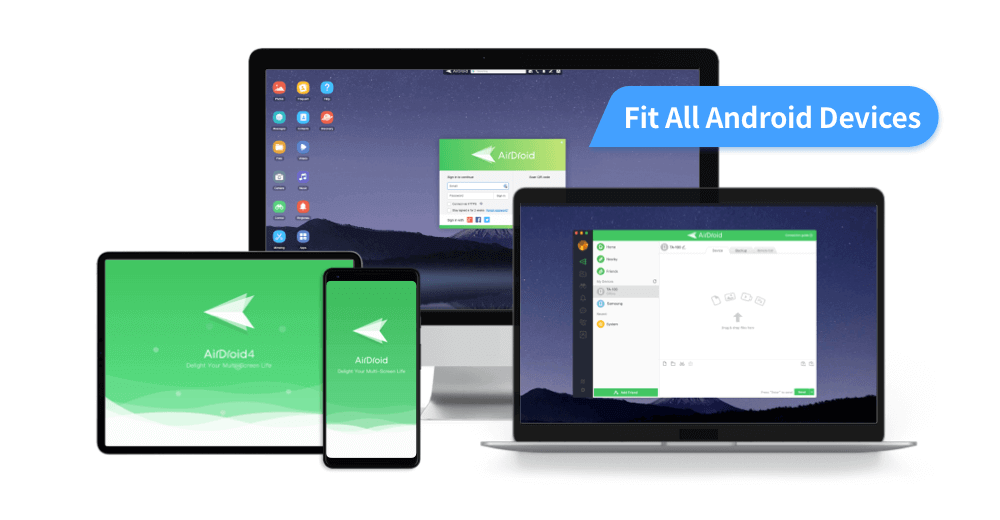
If you find that your primary issue is your Android USB file transfer not working, the problem could be with your device’s USB settings themselves–or, worse yet, the hardware. In this case, getting your Android fixed (or replaced) is the best long-term solution; however, AirDroid is a good compromise in the interim since it does not require a physical USB connection for viewing and transferring Android files. Its simple interface and drag-and-drop file transfer method makes it easy to use in a hurry, and not having to rely on a cable means you can complete file transfers regardless of your Mac’s hardware options.
AirDroid does have a web-based client so that you can transfer files from your Android without downloading a program, but you’ll need to create an account. It’s also worth noting that your file transfer speeds will be notably slower when using AirDroid than you would expect if using a USB cable, even with a strong Internet connection.
How to Use AirDroid
- Download AirDroid onto your computer, then install it.
- Open AirDroid, then click My Devices.
- Use your Android to scan the AirDroid QR code.
- Wait for the connection to complete, then click and drag files between your devices.
Tips to Fix Android File Transfer “Could Not Access Device Storage” Error
As mentioned previously, there are some pretty common and relatively basic issues that can result in your Mac not recognizing Android devices. An explanation of each of these issues, along with advice for fixing them, are elucidated below.
- Check the USB cable. It is possible and, eventually, likely, that your Android’s charger cable will stop working completely. While it should be obvious that something is wrong if the USB cable in question is frayed or bent at a sharp angle, sometimes charger cables will continue charging the phone intermittently without allowing proper access to a computer when connected. You can double-check this problem by trying a different cable when connecting your Android to your Mac.
- Try a different USB port. Occasionally, USB ports can stop working entirely. If Android File Transfer isn’t even acknowledging your Android while it is connected, it’s best to try a different USB port before committing to a more involved solution.
- Switch your Android to file transfer mode. The default option on many Androids is not file transfer mode, it’s a charging mode instead. You should receive a notification about a new USB connection whenever you plug your Android into your computer. If you tap that notification and then select the option to transfer files, it can fix your connection issues.
- Reinstall Android File Transfer. Like any software, Android File Transfer is subject to radical changes with progressively later iterations. Given the possibility of compatibility issues with your Mac, sometimes the easiest way to make sure that the AFT app is working is to uninstall and reinstall it to make sure that you’re running the latest version that is available for your operating system.
- Update macOS and Android. Updating macOS might help allow your Mac to access device storage. If you’re running the most recent version of Android File Transfer and you’re an update or three behind on your macOS versions, it’s probably time to update your Mac.
Conclusion
It can be absolutely maddening to experience the “Android File Transfer could not access device storage” error when you know that your connection should be flawless. There’s no telling what exactly makes for a perfect connection between an Android device and your Mac. Sometimes the smallest idiosyncrasies in one device’s operating system are enough to result in a maddening lack of compatibility. Try the methods we have described in this article to solve this problem.
